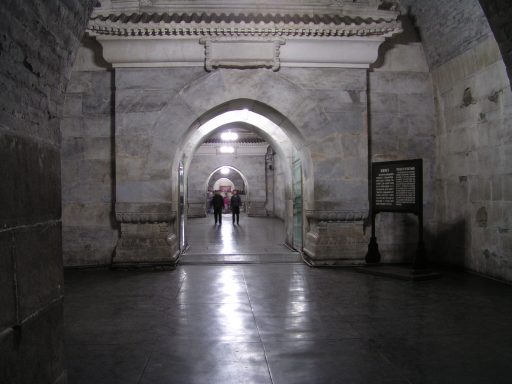From texts provided by the Ming Tombs:The Underground Palace of Dingling was the first 13 Ming imperial tombs ever excavated. With the approval of the State Council of the People's Republic of China, trial excavation began in May 1956 and proved successful in a year. The underground palace was composed of five halls, one in the front, one in the middle, one in the rear, one on the right and one on the left. With a stone latch unfastened, the palace halls measure 1,195 square meters in total area. Over 3,000 cultural objects were unearthed. In 1959, a Dingling Museum was erected on the original site and formally opened to the public.
From Wikipedia:Ding Ling (Chinese: 定陵; pinyin: Dìng Lìng; literally "Tomb of Stability"), one of the tombs at the Ming Dynasty Tombs site, is the tomb of the Wanli Emperor. It is the only one of the Ming Dynasty Tombs to have been excavated. It also remains the only imperial tomb to have been excavated since the founding of the People's Republic of China, a situation that is almost a direct result of the fate that befell Ding Ling and its contents after the excavation.
The excavation of Ding Ling began in 1956, after a group of prominent scholars led by Guo Moruo and Wu Han began advocating the excavation of Chang Ling, the tomb of the Yongle Emperor, the largest and oldest of the Ming Dynasty Tombs. Despite winning approval from premier Zhou Enlai, this plan was vetoed by archaeologists because of the importance and public profile of Chang Ling. Instead, Ding Ling, the third largest of the Ming Tombs was selected as a trial site in preparation for the excavation of Chang Ling. Excavation completed in 1957, and a museum was established in 1959.
The excavation revealed an intact tomb, with thousands of items of silk, textiles, wood, and porcelain, and the bodies of the Wanli Emperor and his two empresses. However, there was neither the technology nor the resources to adequately preserve the excavated artifacts. After several disastrous experiments, the large amount of silk and other textiles were simply piled into a storage room that leaked water and wind. As a result, most of the surviving artifacts today have severely deteriorated, and replicas are instead displayed in the museum. Furthermore, the political impetus behind the excavation created pressure to quickly complete the excavation. The haste meant that documentation of the excavation was poor.
A severer problem soon befell the project, when a series of political mass movements swept the country. This escalated into the Cultural Revolution in 1966. For the next ten years, all archaeological work was stopped. Wu Han, one of the key advocates of the project, became the first major target of the Cultural Revolution, and was denounced, and died in jail in 1969. Fervent Red Guards stormed the Ding Ling museum, and dragged the remains of the Wanli Emperor and empresses to the front of the tomb, where they were posthumously "denounced" and burned. Many other artifacts were also destroyed.

Look on my works, ye mighty, and despair!



